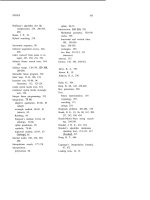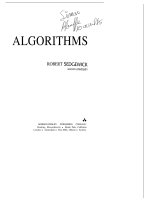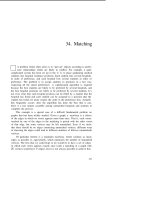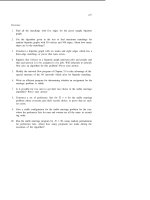Tài liệu Thuật toán Algorithms (Phần 2) docx
Bạn đang xem bản rút gọn của tài liệu. Xem và tải ngay bản đầy đủ của tài liệu tại đây (57.11 KB, 10 trang )
Introduction
The objective of this book is to study a broad variety of important and
useful algorithms: methods for solving problems which are suited for
computer implementation. We’ll deal with many different areas of applica-
tion, always trying to concentrate on “fundamental” algorithms which are
important to know and interesting to Because of the large number of
areas and algorithms to be covered, we won’t have room to study many of
the methods in great depth. However, we will try to spend enough time on
each algorithm to understand its essential characteristics and to respect its
subtleties. In short, our goal is to learn a large number of the most impor-
tant algorithms used on computers today, well enough to be able to use and
appreciate them.
To learn an algorithm well, one must implement it. Accordingly, the
best strategy for understanding the programs presented in this book is to
implement and test them, experiment with variants, and try them out on
real problems. We will use the Pascal programming language to discuss and
implement most of the algorithms; since, however, we use a relatively small
subset of the language, our programs are easily translatable to most modern
programming languages.
Readers of this book are expected have at least a year’s experience
in programming in high- and low-level languages. Also, they should have
some familiarity with elementary algorithms on simple data structures such
as arrays, stacks, queues, and trees. (We’ll review some of this material but
within the context of their use to solve particular problems.) Some elementary
acquaintance with machine organization and computer architecture is also
assumed. A few of the applications areas that we’ll deal with will require
knowledge of elementary calculus. We’ll also be using some very basic material
involving linear algebra, geometry, and discrete mathematics, but previous
knowledge of these topics is not necessary.
INTRODUCTION
This book is divided into forty chapters which are organized into seven
major parts. The chapters are written so that they can be read independently,
to as great extent as possible. Generally, the first chapter of each part
gives the basic definitions and the “ground rules” for the chapters in that
part; otherwise specific references make it clear when material from an earlier
chapter is required.
Algorithms
When one writes a computer program, one is generally implementing a method
of solving a problem which has been previously devised. This method is often
independent of the particular computer to be used: it’s likely to be equally
appropriate for many computers.
In any case, it is the method, not the
computer program itself, which must be studied to learn how the problem
is being attacked. The term algorithm is universally used in computer science
to describe problem-solving methods suitable for implementation as computer
programs. Algorithms are the of computer science: they are central
objects of study in many, if not most, areas of the field.
Most algorithms of interest involve complicated methods of organizing
the data involved in the computation. Objects created in this way are called
data structures, and they are also central objects of study in computer science.
Thus algorithms and data structures go hand in hand: in this book we will
take the view that data structures exist as the byproducts or endproducts of
algorithms, and thus need to be studied in order to understand the algorithms.
Simple algorithms can give rise to complicated data structures and, conversely,
complicated algorithms can use simple data structures.
When a very large computer program is to be developed, a great deal
of effort must go into understanding and defining the problem to be solved,
managing its complexity, and decomposing it into smaller which can
be easily implemented. It is often true that many of the algorithms required
after the decomposition are trivial to implement. However, in most cases
there are a few algorithms the choice of which is critical since most of the
system resources will be spent running those algorithms. In this book, we will
study a variety of fundamental algorithms basic to large programs in many
applications areas.
The sharing of programs in computer systems is becoming more wide-
spread, so that while it is true that a serious computer user will use a large
fraction of the algorithms in this book, he may need to implement only a
somewhat smaller fraction of them. However, implementing simple versions
of basic algorithms helps us to understand them better and thus use advanced
versions more effectively in the future. Also, mechanisms for sharing software
on many computer systems often make it difficult to tailor standard programs
INTRODUCTION
5
to perform effectively on specific tasks, so that the opportunity to reimplement
basic algorithms frequently arises.
Computer programs are often overoptimized. It may be worthwhile to
take pains to ensure that an implementation is the most efficient possible only
if an algorithm is to be used for a very large task or is to be used many times.
In most situations, a careful, relatively simple implementation will suffice: the
programmer can have some confidence that it will work, and it is likely to
run only five or ten times slower than the best possible version, which means
that it may run for perhaps an extra fraction of a second. By contrast, the
proper choice of algorithm in the first place can make a difference of a factor
of a hundred or a thousand or more, which translates to minutes, hours, days
or more in running time. In this book, -we will concentrate on the simplest
reasonable implementations of the best algorithms.
Often several different algorithms (or implementations) are available to
solve the same problem. The choice of the very best algorithm for a particular
task can be a very complicated process, often involving sophisticated mathe-
matical analysis. The branch of computer science where such questions are
studied is called analysis of algorithms. Many of the algorithms that we will
study have been shown to have very good performance through analysis, while
others are simply known to work well through experience. We will not dwell
on comparative performance issues: our goal is to learn some reasonable algo-
rithms for important tasks. But we will try to be aware of roughly how well
these algorithms might be expected to perform.
Outline of Topics
Below are brief descriptions of the major parts of the book, which give some of
the specific topics covered as well as some indication of the general orientation
towards the material described. This set of topics is intended to allow us
to cover as many fundamental algorithms as possible. Some of the areas
covered are “core” computer science areas which we’ll study in some depth
to learn basic algorithms of wide applicability. We’ll also touch on other
disciplines and advanced fields of study within computer science (such as
numerical analysis, operations research, construction, and the theory
of algorithms): in these cases our treatment will serve as an introduction to
these fields of study through examination of some basic methods.
MATHEMATICAL ALGORITHMS include fundamental methods from
arithmetic and numerical analysis. We study methods for addition and mul-
tiplication of integers, polynomials, and matrices as well as algorithms for
solving a variety of mathematical problems which arise in many contexts:
random number generation, solution of simultaneous equations, data fitting,
6
and integration. The emphasis is on algorithmic aspects of the methods, not
the mathematical basis. Of course we can’t do justice to advanced topics
with this kind of treatment, but the simple methods given here may serve to
introduce the reader to some advanced fields of study.
SORTING methods for rearranging files into order are covered in some
depth, due to their fundamental importance. A variety of methods are devel-
oped, described, and compared. Algorithms for several related problems are
treated, including priority queues, selection, and merging. Some of these
algorithms are used as the basis for other algorithms later in the book.
SEARCHING methods for finding things in files are also of fundamental
importance. We discuss basic and advanced methods for searching using trees
and digital key transformations, including binary search trees, balanced trees,
hashing, digital search trees and tries, and methods appropriate for very large
files. These methods are related to each other and similarities to sorting
methods are discussed.
STRING PROCESSING algorithms include a range of methods for deal-
ing with (long) sequences of characters. String searching leads to pattern
matching which leads to parsing. File compression techniques and cryptol-
ogy are also considered. Again, an introduction to advanced topics is given
through treatment of some elementary problems which are important in their
own right.
GEOMETRIC ALGORITHMS comprise a collection of methods for solv-
ing problems involving points and lines (and other simple geometric objects)
which have only recently come into use. We consider algorithms for finding
the convex hull of a set of points, for finding intersections among geometric
objects, for solving closest point problems, and for multidimensional search-
ing. Many of these methods nicely complement more elementary sorting and
searching methods.
GRAPH ALGORITHMS are useful for a variety of difficult and impor-
tant problems. A general strategy for searching in graphs is developed and
applied to fundamental connectivity problems, including shortest-path, min-
imal spanning tree, network flow, and matching. Again, this is merely an
introduction to quite an advanced field of study, but several useful and inter-
esting algorithms are considered.
ADVANCED TOPICS are discussed for the purpose of relating the materi-
al in the book to several other advanced fields of study. Special-purpose hard-
ware, dynamic programming, linear programming, exhaustive search, and
completeness are surveyed from an elementary viewpoint to give the reader
some appreciation for the interesting advanced fields of study that are sug-
gested by the elementary problems confronted in this book.
INTRODUCTION
7
The study of algorithms is interesting because it is a new field (almost
all of the algorithms we will study are less than twenty-five years old) with
a rich tradition (a few algorithms have been known for thousands of years).
New discoveries are constantly being made, and few algorithms are
understood. In this book we will consider intricate, complicated, and difficult
algorithms as well as elegant, simple, and easy algorithms. Our challenge is
to understand the former and appreciate the latter in the context of many
different potential application areas. In doing so, we will explore a variety of
useful tools and develop a way of “algorithmic thinking” that will serve us
well in challenges to come.









